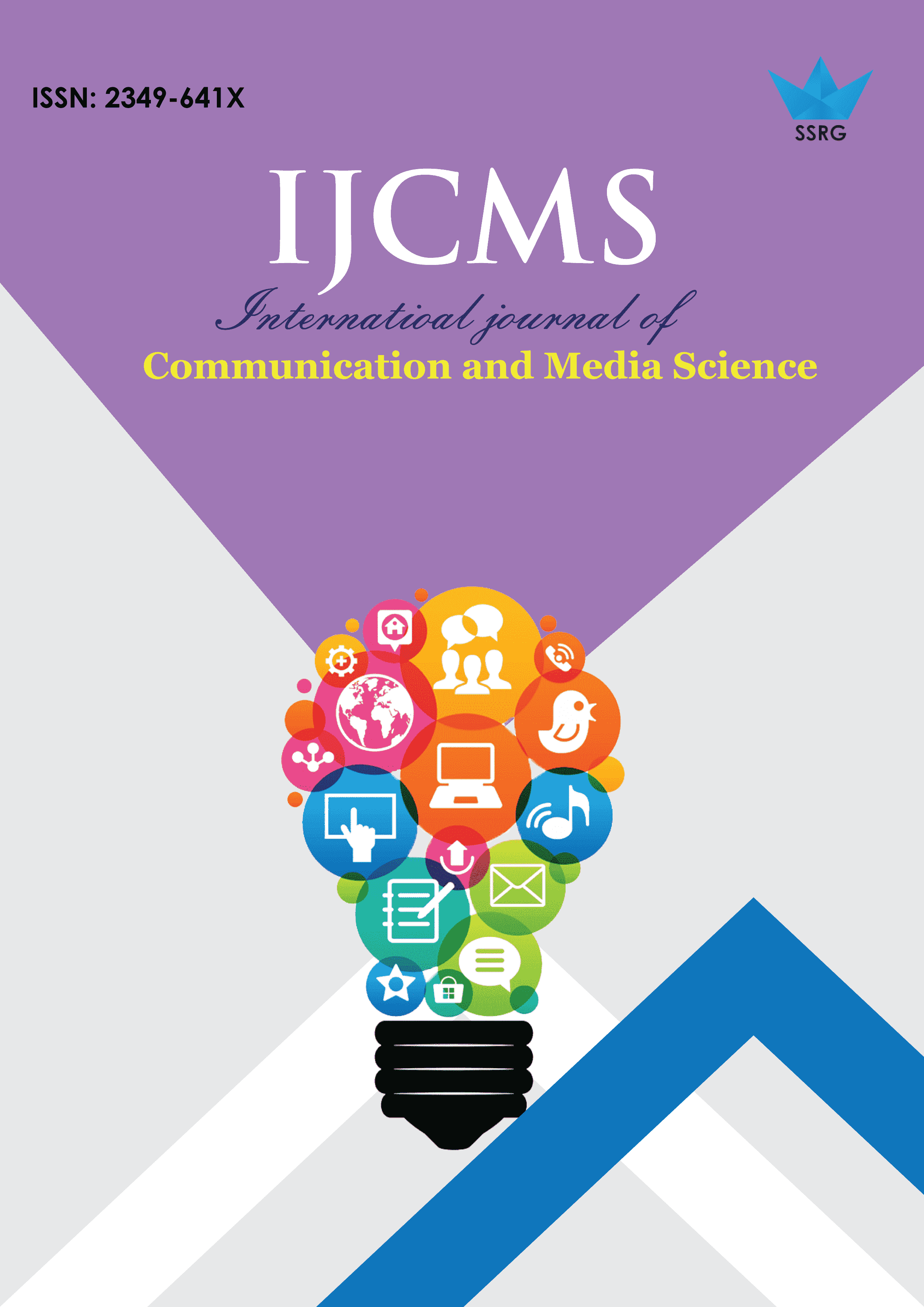From Ethnographic Documentaries to Ethnographic Animation: The Change in the Production Methods and Influencing Factors of Chinese Minority Themed Animations

| International Journal of Communication and Media Science |
| © 2021 by SSRG - IJCMS Journal |
| Volume 8 Issue 3 |
| Year of Publication : 2021 |
| Authors : Dr.Yijing Wang |
How to Cite?
Dr.Yijing Wang, "From Ethnographic Documentaries to Ethnographic Animation: The Change in the Production Methods and Influencing Factors of Chinese Minority Themed Animations," SSRG International Journal of Communication and Media Science, vol. 8, no. 3, pp. 8-16, 2021. Crossref, https://doi.org/10.14445/2349641X/IJCMS-V8I3P102
Abstract:
China is a multi-ethnic country. Each ethnic minority group has different cultural characteristics. The stories, myt¬hs, and legends of ethnic minorities also provide material and inspiration for the creation of Chinese documentaries and animations. With the influence of postmodernism and the borrowing of international practice projects, various new attempts have been made in the shooting methods of Chinese minority documentaries after 2000. These new attempts have strengthened the initiative of ethnic minorities as cultural subjects in the production of ethnographic documentaries. Meanwhile, in animation, the concept of Ethnographic Animation and the method of working with ethnic minorities have also attracted more attention from scholars.
Keywords:
ethnographic animation, ethnographic documentaries, influencing factors, Chinese minority, participatory design
References:
[1] N. Meng, X. Q. Jia, The Realistic Dilemma and Consideration of the Development of Domestic Minority Animation Films (国产少数民族动画电影发展的现实困境与思考), Contemporary Cinema. 2017(6) (2017) 153-155.
[2] J. Ruby, Is an ethnographic film a filmic ethnography?, Program in Ethnographic Film Newsletter.2(2) (1975) 104-111.
[3] J. J. Zhu, The Development Trend of Contemporary Anthropological Image (论当代人类学影像民族志的发展趋势),World Ethno-National Studies. 2011(6) (2011) 44-50.
[4] B. L. Duan, Analysing the Impact of Victory in the World Anti-Fascist War through the Post-war National Independence Movement, (从战后民族独立运动看世界反法西斯战争胜利的影响),China Party and Government Cadres Forum.1995(9) (1995) 39-40.
[5] B. Ashcroft, G. Griffiths, and H. Tiffin, The post-colonial studies reader, Abingdon, OX: Taylor & Francis. (2006).
[6] G. E. Marcus, M. M. Fischer, Anthropology as cultural critique: An experimental moment in the human sciences, Chicago: University of Chicago Press. (1999).
[7] C. Ghasarian, P. Rabinow, Essays on the Anthropology of Reason, L'Homme. 37(144) (1997) 155-157.
[8] G. C. Spivak, Can the subaltern speak?, The post-colonial studies reader, Abingdon, OX: Taylor & Francis. (2006) 28-37.
[9] X. Li, Opium War and the Opening of Modern China (鸦片战争与近代中国的开放), Journal of Shandong University: Philosophy and Social Sciences Edition. 1990(2) (1990) 17-18.
[10] J. Wang, The Evolution of Chinese Mentality towards Western Culture in Modern Times (近代以来中国人对西方文化的心态演变), Journal of Jinan Municipal Party School. 2016(1) (2016)73-78.
[11] N. Papastergiadis, The turbulence of migration: globalization, deterritorialization and hybridity,Hoboken, NJ: John Wiley & Sons. (2013).
[12] P. Hopper, Understanding cultural globalization, Cambridge: Polity. (2007).
[13] C. D. Zheng, Poverty in Ethnic Minority Areas in Western China (中国西部民族地区贫困问题研究),Population and Economy.2003(1) (2003)1-1.
[14] L. C. Su, W. X. Zhu, and K. N. Xiong, Desertification in Guizhou Karst Mountains and Its Eco-economic Governance Model (贵州喀斯特山区的石漠化及其生态经济治理模式),Carsologica Sinica. 21(1) (2002) 19-24.
[15] M. Q. Yang, Analysis of the Literature Value of Miao Ancient Songs (苗族古歌的文献价值浅析),Wuhan: South-Central University for Nationalities. (2009).
[16] C. Wu, Architectural Culture and Its Changes in Longhorn Miao Nationality in Suojia (梭戛长角苗民居建筑文化及其变迁), Beijing: Chinese National Academy of Art. (2007).
[17] J. C. Feng, How is culture made conscious (文化怎么自觉),Party & Government Forum. 2011(37) (2011)1-1.
[18] S. Stryker, T. J. Owens, and R. W. White, Self, identity, and social movements. Minneapolis, MN: University of Minnesota Press. (2000).
[19] N. Gizem Koçak, Social and Individual Impacts of Social Media and Its Interactions with Traditional Media, SSRG International Journal of Communication and Media Science ( IJCMS ). 4(2) (2017) 1-7.
[20] L.L. Fang, Diary of Suojia (梭戛日记), Beijing: Xueyuan Press.(2010).
[21] D. M. Fetterman, Ethnography: Step-by-step, Thousand Oaks, CA: Sage. (2010).
[22] K. Knopf, Decolonizing the lens of power: Indigenous films in North America, Amsterdam: Rodopi. (2008).
[23] J. A. Van Dijk, Digital divide research, achievements and shortcomings, Poetics. 34(4-5) (2006) 221-235.
[24] Q. Zhao, Digital Divide and Information Service in Minority Areas in West China (西部少数民族地区的数字鸿沟与信息服务), Journal of Modern Information. 2007(3) (2007) 51-53.
[25] Z. D. Mao, Selected Works of Mao Zedong Volume Five (毛泽东选集第五卷), Beijing: People’s Polishing House. (1977).
[26] J. J. An, Beautiful legend of cultural treasures - from the cultural heritage point of view of Huo Tong (美丽传说文化瑰宝——从文化传承角度看火童),Masterpiece Review. 2011(36) (2011) 166-167.
[27] J. Kumar, Animation in Sculptures in Chola Temples , SSRG International Journal of Communication and Media Science ( IJCMS ). 3(2) (2016) 18-22.

 10.14445/2349641X/IJCMS-V8I3P102
10.14445/2349641X/IJCMS-V8I3P102